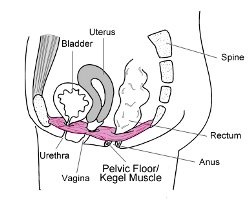Pelvic Floor Muscles
 diagram of pelvic floor muscles and its environ
diagram of pelvic floor muscles and its environThe pelvic floor muscles are referred to by some as “the love muscles”. They surround the vagina and the clitoris and contribute to a woman’s sexual function and satisfaction.
You may not be aware of its significance, but for your body the pelvic floor is an essential part of your body’s core, the essence of your very being.
Located at the base of the abdomen and adjacent to the vaginal canal, they:-
- Support the bones in the spine, which helps to prevent back pain.
- Structure the abdominal cavity - muscles and organs included.
- Control the passage of urine and stool.
- Facilitate the childbirth process.
- Contribute to a woman’s sexual pleasure and ability to reach orgasm.
On the contrary, when the strength of the pelvic floor is compromised, you may experience the following symptoms:-
- Urinary or stool incontinence
- Constipation or incomplete bowel or bladder emptying
- Painful intercourse
- Inability to reach orgasm
- Pelvic organ prolapsed whereby the bladder or uterus protrudes into the vaginal canal
- Lower back or lower abdominal pain
It is not uncommon for women to lose their pelvic muscle tone after pregnancy and childbirth. In fact 6 out of 10 post pregnancy women are prone to diminished sexual sensations and urine leakage when they cough, sneeze or laugh too hard.
Why Do The Pelvic Floor Muscles Lose Its Strength?
Other than pregnancy and childbirth, the pelvic floor can lose its tone and flexibility whenever its muscles, tendons, ligaments or nerves are weakened. This can happen as a result of:-
- Episiotomy (a surgical cut in the muscular area between the vagina and the anus (perineum) made just before delivery to enlarge the vaginal opening
- Caesarean section
- Large uterine fibroids
- Smoking and the associated chronic coughing
- Frequent straining during bowel movements or lifting heavy objects
- Obesity, Menopause and Hysterectomy
- Diets high in processed foods
Strengthening The Pelvic Floor Muscles
In addition to practicing Kegels (see instructions here), there are numerous options and exercises that can help strengthen and gently stretch the pelvic floor.
Perineal Massage
Massaging the perineum (the area between the vagina and the rectum) involves lubricating the thumbs and inserting them inside the bottom of the vagina. Then you exert downward pressure toward the back of the spine. This can be done by any woman seeking to enhance the flexibility of the pelvic muscles.
Vaginal Exercisers
Vaginal exercisers make it easier for you to locate and isolate the proper muscles of the pelvic floor to work on. They enhance your kegels and you will get results faster. They can be in the form of weighted pelvic exerciser, ben-wa balls or kegel exerciser.
Squatting
Squatting encourages the stretching of the pelvic muscles. No matter how young or old we are, squatting is incredibly good for the pelvic floor. The more we do it the greater ease and core strength we will enjoy.
Pilates And Yoga
You will be amazed with your pelvic floor muscle tone and flexibility when you do pilates and yoga regularly. Best of all these two forms of exercise help to tighten the vagina. You will enjoy sensational sex when you have stronger grip and contractions during orgasm.
Diet And Nutrition
A diet high in soy protein and low in processed foods will help to maintain muscle tone in every part of your body, yes, even in your vagina and breasts. Having lot’s of soy protein in your diet will help to combat obesity, which will protect your pelvic floor from the stress of the excess body weight.

To further enhance vaginal tightness either supplement with manjakani vaginal tightening pill or apply the Manjakani Feminine Gel for better sexual sensations and satisfaction for both partners.
Continue reading manjakani pill and gel here
Quit Smoking
Studies have shown that women who smoke are more susceptible to pelvic floor problems. Stop smoking will maximize your body’s absorption of nutrition. And prevent the chronic coughing, one of the primary triggers for weakened pelvic floor muscles.
Practice Good Bowel & Bladder Habits
Make it a habit to go to the toilet regularly. Holding it may cut down how much your bladder can hold.
Make time to strengthen or maintain your pelvic floor muscle tone. It’s our foundation, and there is so much we can do to preserve and restore it.
Back to top- Home
- Vagina Tightening
- Vagina Exercise
- Pelvic Floor Muscles

Facebook Comments
Thanks for visiting. Have your say on what you just read? Leave a comment in the box below!